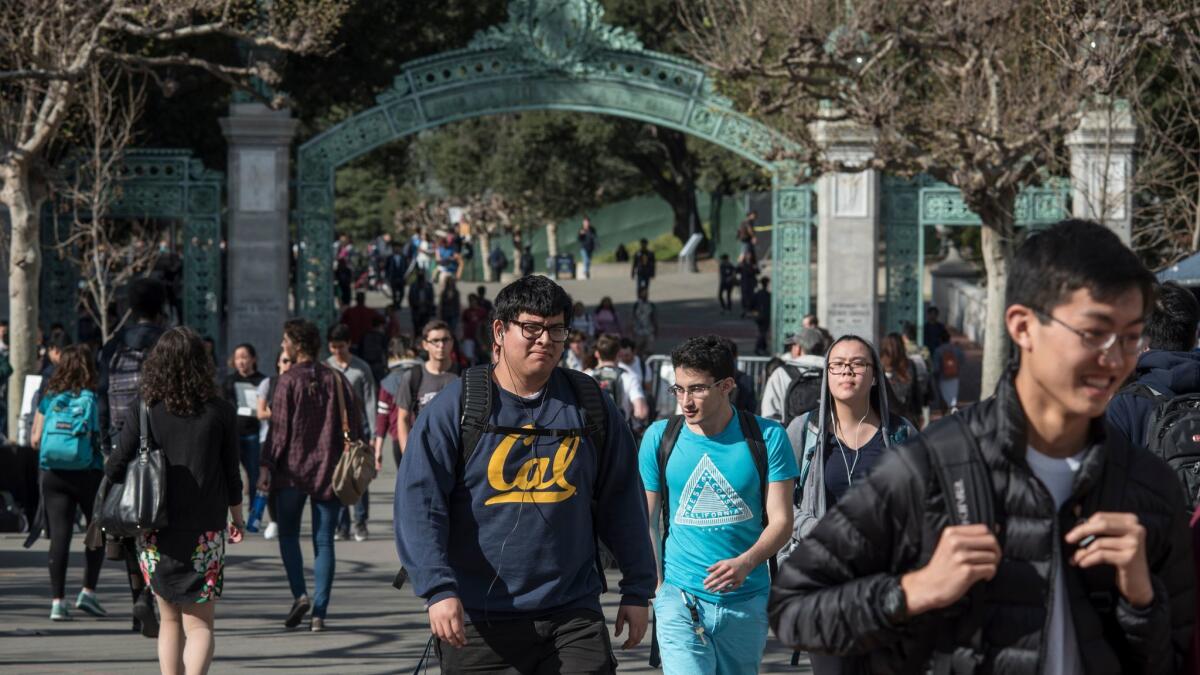Editorial: How many high-paying out-of-state students is enough for UC?

Here’s one big reason for admitting out-of-state students to the undergraduate ranks of the University of California: money. Those students pay close to $30,000 more for their education each year than the locals do. Among other things, that helps pay for students from California who can’t afford the in-state tuition of less than $15,000.
At the same time, Californians are clamoring for more access. UC President Janet Napolitano has long claimed that the tripling of out-of-state enrollment over the past decade or so hasn’t harmed California students because the university didn’t reduce their numbers; it simply added more from out of state. A 2016 state audit disagreed.
It’s a complicated picture. Obviously, if UC accepted more students from out of state, those seats didn’t go to Californians. But if it hadn’t drawn those extra dollars, the results wouldn’t have been good for in-state students either — the state would have been forced to raise in-state tuition or cut financial aid for lower-income Californians.
Under pressure from Sacramento to do more for Californians — and with additional funding to make it happen — the university system has significantly increased its admission of state residents. Now Napolitano is responding to Sacramento’s other concern by proposing a 20% systemwide cap on out-of-state enrollment.
Should schools be mainly reserved for California’s students, even if that means having to skimp on the university’s offerings for lack of money?
Last week the Board of Regents put off making a decision, citing various concerns about the cap. But although Napolitano’s plan needs some tweaking, the 20% limit she proposes strikes the right balance. The regents need to make some kind of decision on this; the issue won’t go away.
And it’s about more than money. This is an unresolved struggle over the very identity of UC. Should its undergraduate schools be mainly reserved for California’s students, even if that means having to skimp on the university’s offerings for lack of money? Or should it go for gold by enrolling large numbers of nonresidents, which might fund a more robust university overall? Supporters of the latter also point out that by admitting top students from far and wide, public universities gain a measure of prestige. And campuses become more diverse: Students attend class with people from around the country and the world, learning different perspectives and making contacts they might keep for many years.
California isn’t the only state that has grappled with this issue. During the recession, cuts in state budgets often meant a search for outside sources of funding for state university systems.
The University of Virginia long ago went the national route as a way of bringing in cash and building a national reputation. It admits a third of its students from out of state. The University of Michigan at Ann Arbor, another famed state university, enrolled barely more than half of its freshman class this year from within the state. The University of Alabama made a dramatic shift during the recession: In 2004, most of its students came from Alabama, but by 2014, only a third of them did. In contrast, Texas A&M stuck with a serving-the-state policy, with Texans making up 95% of its enrollment.
Nine years ago, UC’s numbers looked much like those at Texas A&M. But the percentage of in-state undergraduates has shrunk to 83.5%, and at Berkeley and UCLA, the number dropped to 70% among the 2015 freshman class.
With the state in no position to dramatically increase UC funding, there’s no returning to the days of 95% in-state enrollment in the foreseeable future. But Californians need great institutions of subsidized higher education; this is still a California institution that shouldn’t go the way of those in Virginia or Michigan or, far worse, Alabama.
Napolitano has found a fair compromise. A reasonably small but significant nonresident enrollment would diversify campuses, give UC continued national stature as an undergraduate institution and provide significant extra funding. It also might be wise to add some flexibility to the guidelines so that the number of out-of-state enrollees can increase somewhat during recessions, when funding is scant, with orders for them to decrease as soon as the state budget improves.
One worthwhile concern was raised at the regents’ meeting: Napolitano’s proposal would allow Berkeley, UCLA and San Diego to keep their higher-than-20% shares of nonresidents, which would mean smaller numbers at other campuses to maintain the 20% cap overall. That’s simply unfair; every campus should have an equal opportunity to raise new funding, and California students shouldn’t see their chances of getting into the most competitive campuses reduced because higher numbers of nonresidents are accepted there.
Follow the Opinion section on Twitter @latimesopinion and Facebook
More to Read
A cure for the common opinion
Get thought-provoking perspectives with our weekly newsletter.
You may occasionally receive promotional content from the Los Angeles Times.






